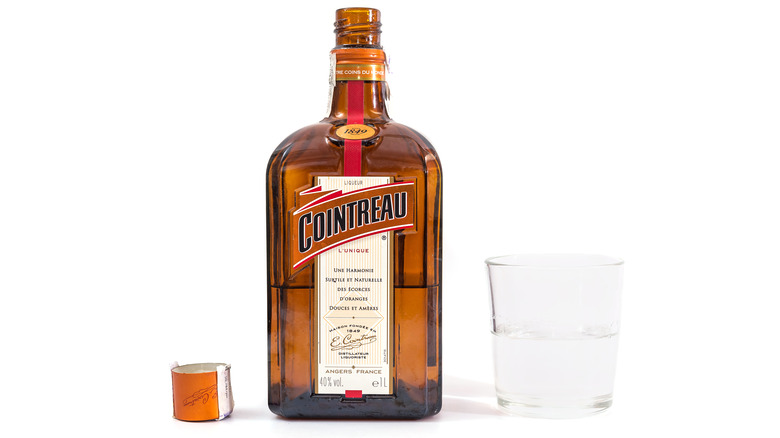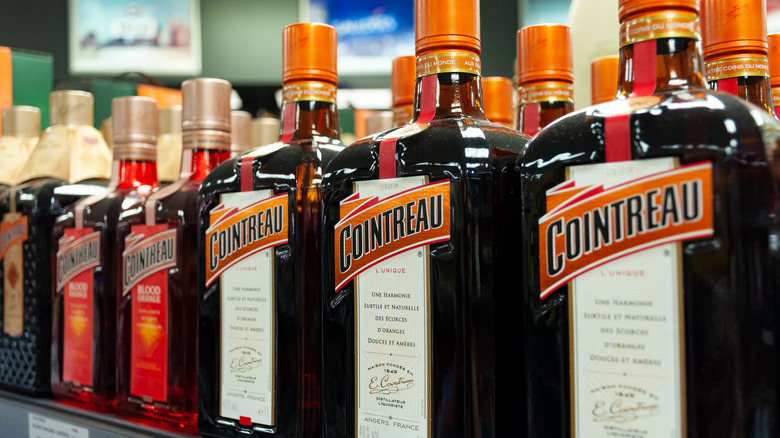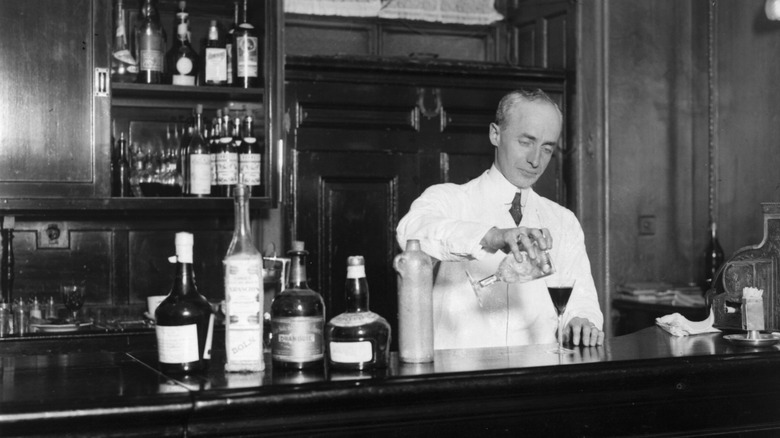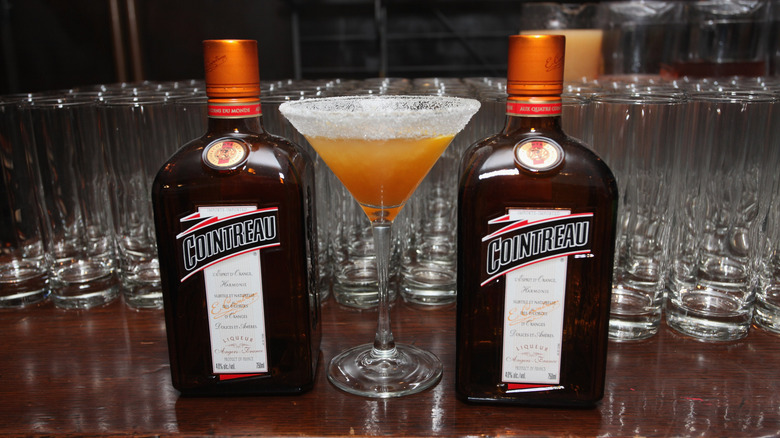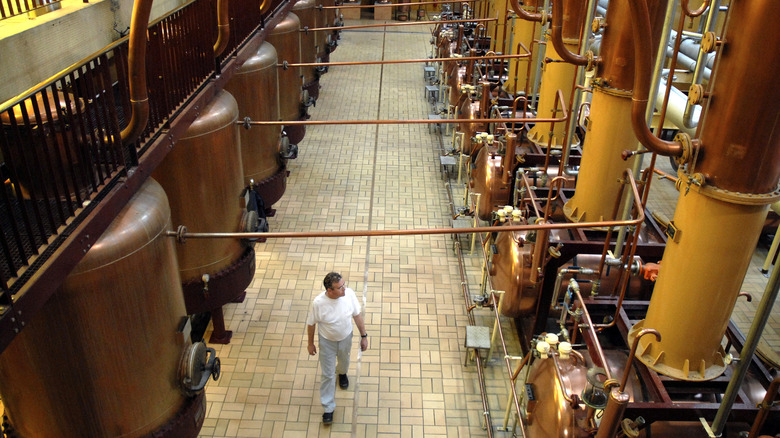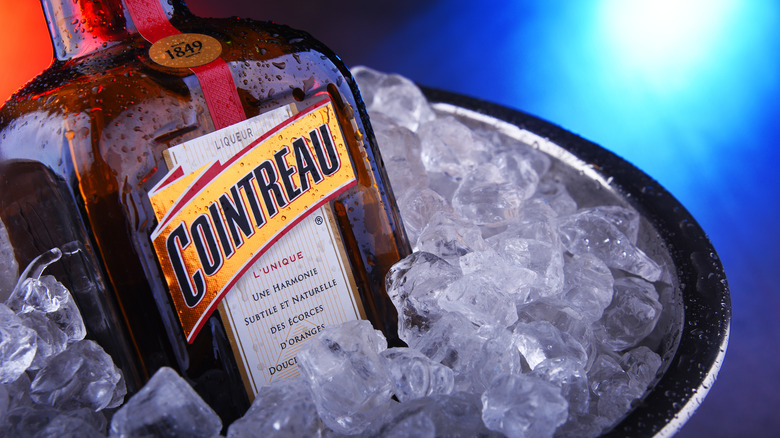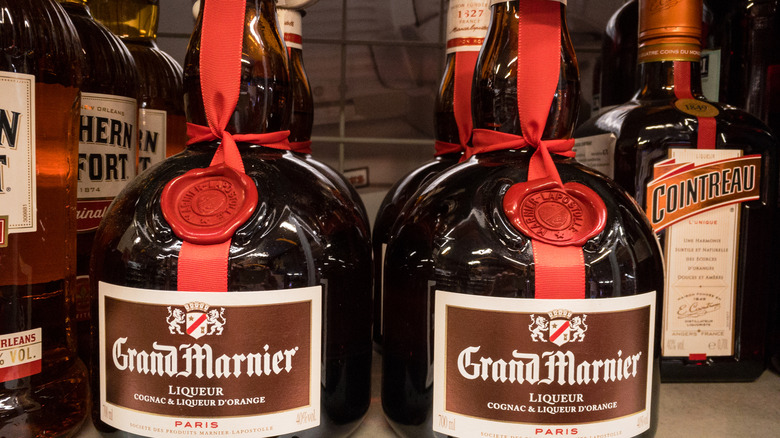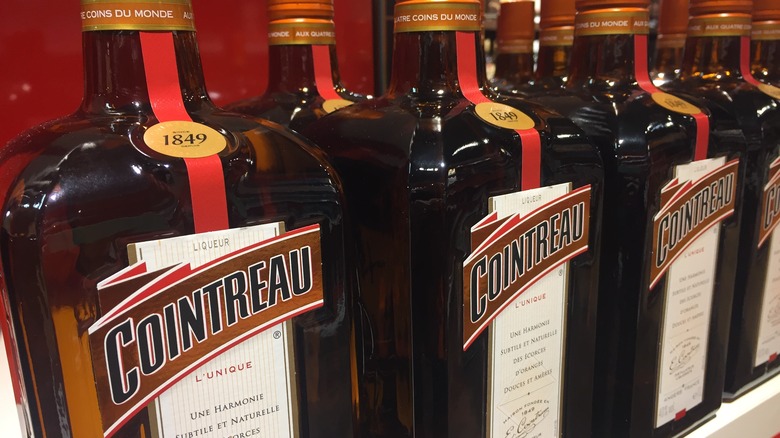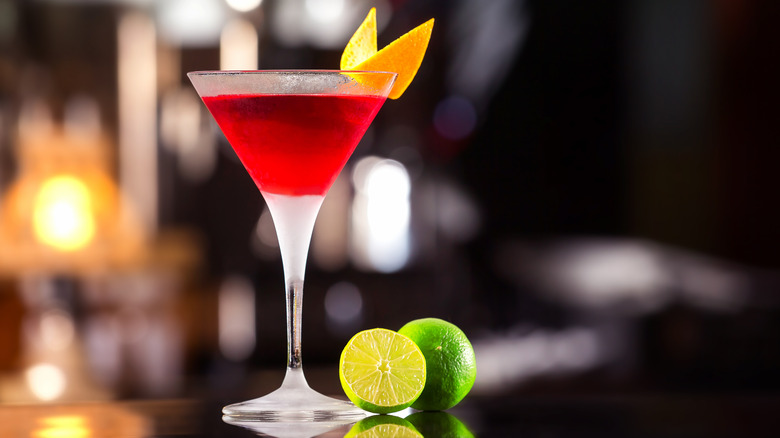Cointreau: The Ultimate Bottle Guide
We may receive a commission on purchases made from links.
Cointreau has long been considered a premium orange liqueur, but there are a lot of questions surrounding the brand. Is it a triple sec? Is it interchangeable for Grand Mariner? Cointreau has also conjured plenty of intrigue over the years with secretive and long-standing production methods that allowed it to become a legendary ingredient in early 20th-century craft cocktail history. To this day, Cointreau holds ties to premier events around the world.
Whether you're looking to upgrade a margarita or you're simply curious about what exactly is inside that iconic square-shaped bottle, consider our liqueur guide to be your ultimate primer on this fascinating orange spirit. Being a mysterious yet famous spirit, it's worth knowing about Cointreau's unique history, innovation, and product, along with being wise to practical information — how it tastes, what it costs, where to find it, and when to serve it. You may become inspired to start utilizing Cointreau's classic profile, which has been linked to Zelda Fitzgerald, the world-renowned Savoy Hotel, and even the Cannes Film Festival.
Cointreau was created by a family of candy makers
The house of Cointreau was first established in 1849 when Adolphe Cointreau was looking to expand his family's business. Adolphe was a confectioner, and his kin came from a long line of bakers (via Food & Wine). Accordingly, the Cointreaus figured that their family's experience with sweet, fruity treats would translate well to liqueurs. Per The Spirits Business, Adolphe first began with bottles of Guignolet, a type of cherry liqueur that was popular at the time. With success, he began construction that year on his first distillery in the beautiful city of Angers, which is found in France's Loire Valley. Immediately, the brand was off to the races, creating 50 flavors of liqueurs. Adolphe's brother, Édouard-Jean, joined him in business in 1856.
In 1857, an orange liqueur recipe fatefully appeared in the brothers' recipe books. Édouard-Jean's son, Édouard, decided to hone in on this particular flavor when he took over the brand in 1875. He registered the trademark, and Cointreau's now-iconic square bottle, bringing the brand's new orange liqueur to The World's Fair in Paris in 1889. It was a major hit and was awarded a medal for its quality. Four years later, it won again, this time in the U.S. at The World's Fair in Chicago. Cointreau has remained on the world stage ever since.
Cointreau is the original triple-sec (probably)
High praise from the fairs in Paris and Chicago helped Cointreau's fame spread from New York City's pre-Prohibition cocktail bars to the Tsar Empire in Russia. As popularity moved internationally (the company's slogan famously became "la marque mondial" or "the worldwide brand"), Cointreau needed to have a global appeal (via Spirits Platform). Édouard tampered down the sweetness by changing the recipe and adding a new mix of sweet and bitter orange peels. By calling it a triple sec or triple-dry liqueur, Édouard's title was intended to describe the character of a formula that was both triple-concentrated with orange flavor and yet relatively dry (via The Spirits Business).
Even more importantly, Édouard Cointreau may have invented the triple sec category, but according to Spirits Platform, he could not copyright the words. Combier, another Loire Valley producer of triple sec, also claims to have invented the category. Cointreau may at least have the legal edge here. Bevvy writes that today's Rémy Cointreau brand relies on an 1885 record filed with an Angers commercial court to show Cointreau as the first registered triple sec brand. Though he is often credited with inventing the category, many imitators followed, and The Spirits Business writes that Édouard soon wanted Cointreau to be separated from the class of triple sec. This is why you won't find it on the bottle today.
Cointreau played a major role in a 20th century craft cocktail revolution
This clear orange liqueur in a square bottle became a legendary aspect of craft cocktail culture at the turn of the 20th century. As told by Rémy Cointreau, Cointreau was first recognized in a 1913 cocktail recipe book, "Der Mixologist," by Carl A. Seutter. Édouard Cointreau also began innovating with advertising and marketing techniques, establishing an in-house agency that produced everything from a Cointreau "advertising car" in 1903 to the brand's first-ever film commercial (via Cointreau). It wasn't long before Cointreau exploded onto the burgeoning craft cocktail scene. Over the next three decades, the liqueur quickly appeared as an ingredient in many now-iconic cocktail recipes.
Cointreau was used in the original 1920s recipe for a White Lady, which is rumored to have been created for Zelda Fitzgerald at the legendary Savoy Bar in London, according to Adrienne Stillman's "Spirited: Cocktails From Around the World" (via Phaidon). As the story goes, Fitzgerald's platinum locks inspired the bartender to create this historic pre-Prohibition libation. The brand claims that Cointreau also was used to create the original Sidecar recipe at Harry's Bar, and was featured in "Harry's ABC of Mixing Cocktails".
After a quiet 26 years, Cointreau made cocktail history again with the 1948 invention of the margarita in Acapulco. More recently, Toby Cecchini created the Cosmopolitan at The Odeon in New York City in 1988. The drink has become legendary after HBO's "Sex & The City" popularized it in the '90s.
Cointreau remains an icon of glamour today
While Cointreau fought hard to earn its global presence through its innovative advertising campaigns and bottle design, the bottle's best press was its inclusion on the shelves of innovative bars. One of these was The Savoy, a preeminent five-star hotel of the early 20th century and the first of its type in Britain, according to the property. The hotel's legendary bar served guests ranging from the Royal Family to whichever Hollywood starlets were dominating the screens at the time. If they hadn't already been exposed to Cointreau, the rich and famous were offered the ultimate experience at The Savoy Bar, whose eponymous cocktail book features seminal recipes using the orange liqueur, like the White Lady and X.Y.Z. cocktails. In this position, it didn't take long for Cointreau to become synonymous with luxury.
Cointreau has remained an icon of opulence, most notably through the brand's involvement with the Cannes Film Festival. In 1989, Cointreau merged with Rémy Martin, the luxury cognac brand, becoming Rémy Cointreau. Now, it is an official supplier of the festival. 7x7 has reported that the brand has even been tasked with selecting cocktail ambassadors from the most prestigious bar programs across the U.S. to create a signature libation for the festival's A-list guests. Cointreau is also celebrated at other premier events around the world, like the Newport Mansions Food & Wine Festival (via The Beverage Journal).
How Cointreau is made
It's a common misconception that Cointreau is what makes a margarita or Cosmopolitan sweet. Liquor.com writes that while Cointreau is made with natural beet sugar fermented into alcohol, this liqueur is a dry spirit that's more aromatic than sweet. According to company information, Cointreau is made with peels from various sweet and bitter types of oranges sourced from across the globe and especially distilled to retain the peel's fragrant essential oils while requiring less sugar. Cointreau reports that one bottle of their liqueur can contain oranges from Brazil, Ghana, Senegal, Spain, and Tunisia. The special distilling process is why substituting another type of triple sec may cause a cocktail to taste a little different or sweeter.
Cointreau is still produced at the same distillery Adolphe dreamed up more than 170 years ago, which means every bottle purchased around the world was made in the same room, per information from the brand. Their practice may be old, but the Cointreau process is now state of the art. As reported by PR News Wire, the distillery underwent a major renovation in 2020 and is now reopened to tourists.
What it tastes like
Cointreau is 80 proof, meaning it's 40% alcohol by volume (via Serious Eats). This is much higher than most fruit liqueurs, as the average is around 20% alcohol by volume, per Drinks Geek. This means Cointreau will have a drier, sharper, more potent taste than other bottles you may have tried in this category.
While much of the triple sec sector sources its oranges exclusively from the Caribbean, according to Luxe Digital, Cointreau's taste is unique because its world collection of citrus offers a more complex flavor. Accordingly, the company prides itself on featuring more than 40 olfactive notes, which create Cointreau's diverse, heady aromas. The Cointreau bottle label boasts that drinkers will experience harmony in their tasting, and true enough notes range from fruity to vegetal and zesty to spicy. At the helm of the flavor profile is a balance of sweet and bitter orange flavor with warm spices at the finish. And while this liqueur is exceptionally fragrant, drinkers will be pleased to find it has a clean finish to match a crystal coloring.
Cointreau vs. Grand Marnier
While orange liqueurs like Cointreau and Grand Mariner are often thought to be used interchangeably in cocktail recipes, the two are very different. Grand Mariner is a type of orange liqueur, but it is not a type of triple sec. According to The Spruce Eats, Grand Mariner is a brandy-based orange liqueur made with Cognac, giving it a different flavor and a darker color. In fact, Grand Mariner was initially named "Curaçao Mariner," so it is closer to a curaçao than a triple sec. Grand Mariner is also only made with one type of bitter orange instead of three, and it is aged, whereas Cointreau is distilled and unaged, according to My Recipes.
However, there are still plenty of similarities between the two. Both were born in France during the late 19th century, and both bottles are 80 proof, which is higher than most other orange liqueurs. My Recipes writes you can substitute one for the other if needed in cocktails, but you'll have to add more Cointreau when replacing Grand Mariner since the latter has more intensity of flavor. However, it is recommended to stock your bar cart with both a light and a dark orange liqueur, per The Spruce Eats, so having both Cointreau and Grand Mariner on hand at all times will ensure you can create cocktails with the best flavor profiles possible.
What Cointreau costs and where to buy it
Cointreau began to garner a global presence over one century ago, and since that time, this orange liqueur has established itself as a standard. Now, it is widely available in liquor stores worldwide and through online retailers such as ReserveBar, Drizly, and Total Wine. In the U.S., Cointreau can sometimes be found in big-box stores like Target — and it's even easier to find in the U.K. and Australia as it is sold on Amazon and at Costco.
Like many items, particularly in the food and beverage space, Cointreau is rising in price. While a 750mL bottle was previously selling for $30-$35 in 2021 (according to A Couple Cooks), Cointreau is now more often sold for $45-50, depending on the retailer you shop. Reporting from Reuters tracks that the Rémy Cointreau brand has been on a cycle of raising its prices in recent years. It's worth seeking several buying options before purchasing a bottle if you're looking for the best deal. Thankfully, Healthline writes that fruit-based liqueurs have a six-month shelf life once opened. That said, you'll have plenty of time to use your Cointreau, considering the many cocktails it is a staple of. Plus, 375mL bottles of Cointreau are also pretty easy to find and currently retail for $25, according to Drizly.
How to serve it
Bartenders and home mixologists can use Cointreau in a wide variety of cocktails and crowd-pleasing libations styles. The orange liqueur was part of bartending legend Harry Craddock's recipe for a Corpse Reviver #2, featured in "The Savoy Cocktail Book." Another of Craddock's cocktail creations with Cointreau is the Calvados Cocktail, also featured in his wildly popular recipe book. Cointreau was an essential ingredient in many of his creations, some of which are significant moments in craft cocktail history.
Besides historical and traditional uses, Cointreau can have use in a host of other popular drinks such as the Mai Tai, Vodka Sour, Sangria, and even a Long Island Iced Tea, according to A Couple Cooks. Though we've seen that Cointreau is not defined as a triple sec, it can be used in just about any drink recipe that calls for it (or similar orange liqueur). Just remember that if a formula calls for Grand Mariner, you'll need to add a bit more Cointreau when substituting.
Finally, Cointreau can be enjoyed on its own. It can be served neat, over ice, and as both an aperitif or digestif (via MarthaStewart.com). Per advice from the home site, orange liqueurs are more commonly consumed alone after a meal. As Wine Enthusiast has it, Cointreau is considered a top-shelf triple sec. This makes it incredibly versatile for your needs — it will support the simple or carry the complex. Bottoms up!
